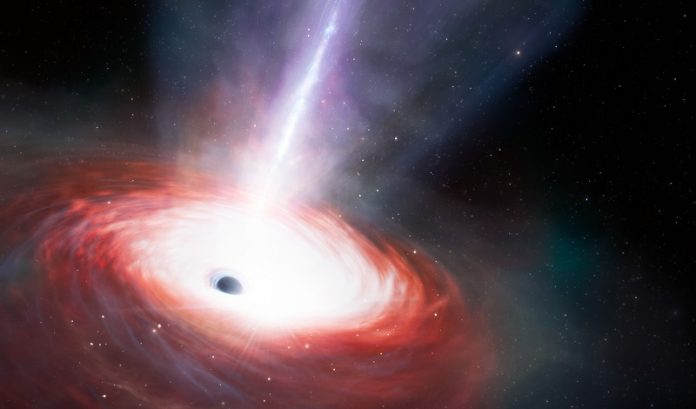
Astronomers have discovered a black hole in the early universe that is consuming matter at an astonishing rate—more than 40 times the theoretical limit.
This discovery offers new clues about how black holes in the universe’s youth grew so large so quickly.
The black hole, known as LID-568, was found in a galaxy only 1.5 billion years after the Big Bang.
A team of astronomers led by Hyewon Suh from the International Gemini Observatory and NSF’s NOIRLab used the James Webb Space Telescope (JWST) to make this groundbreaking observation.
Supermassive black holes are known to sit at the centers of most galaxies, but spotting one in the early universe, and one that grows so fast, is rare.
Scientists previously struggled to understand how these black holes could become so massive so quickly after the universe began. Observing LID-568 has helped shed new light on this mystery.
The researchers first identified LID-568 in a group of galaxies noted for being very bright in X-ray observations from NASA’s Chandra X-ray Observatory.
However, they needed the JWST’s advanced infrared capabilities to pinpoint LID-568’s location and study it in more detail, as it’s invisible in regular optical wavelengths.
LID-568’s intense X-ray emissions suggested that it was highly active, but its faint light meant that it was challenging to observe.
To capture all the details, Suh’s team used JWST’s integral field spectrograph, an instrument that records spectra for every pixel in its field of view.
This allowed the team to see the black hole and the region around it more clearly than ever. As they analyzed the data, they discovered intense outflows of gas around the black hole—an indication that it was consuming matter at an extraordinary rate.
Normally, black holes have an “Eddington limit,” which caps the speed at which they can pull in matter. If a black hole tries to absorb matter too quickly, the pressure from the heated, infalling material would push back, slowing down the intake. But LID-568 seems to defy this limit, “feasting” on material 40 times faster than previously thought possible.
“This black hole is having a feast,” says Julia Scharwächter, an astronomer on Suh’s team. Such extreme “super-Eddington” feeding could explain how black holes grew so large in the early universe. The gas outflows seen around LID-568 may act as a safety valve, releasing excess energy and allowing the black hole to remain stable even at this high rate of consumption.
This discovery supports theories that black holes could grow rapidly through intense feeding episodes. Scientists believe this may occur whether a black hole starts as a “light seed” from the death of the universe’s first stars or as a “heavy seed” from collapsing gas clouds. Observing LID-568 gives astronomers the chance to study this process in action for the first time.
The team plans to conduct more observations with JWST to better understand how black holes can exceed their growth limits, shedding light on the evolution of supermassive black holes in the universe.



